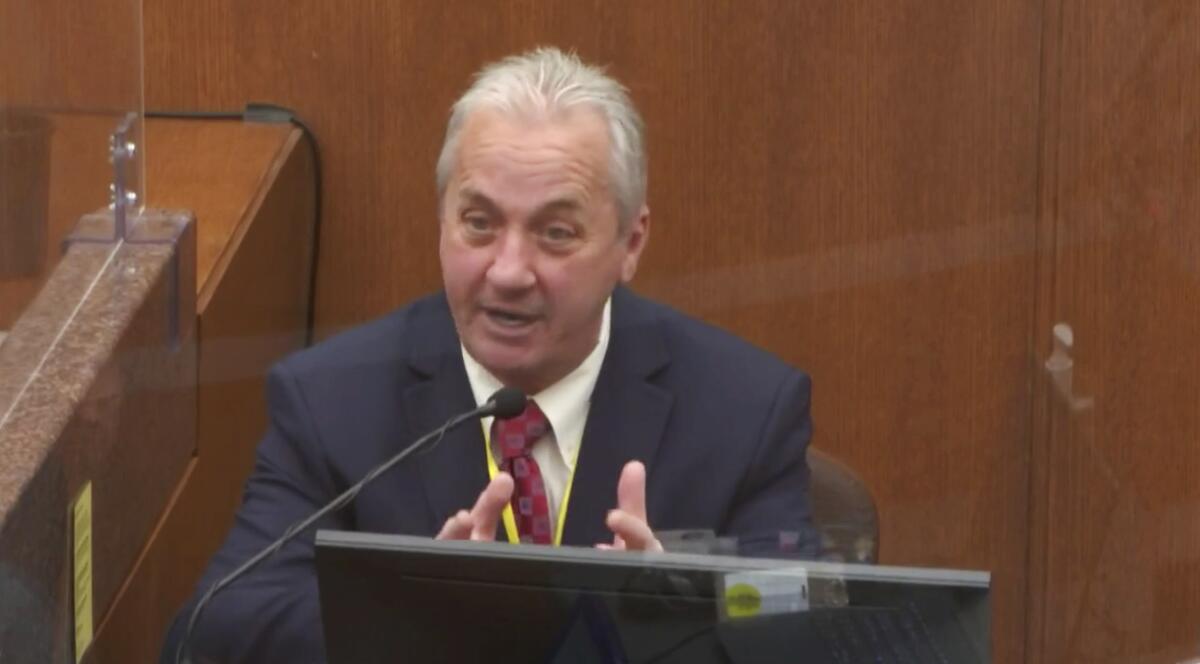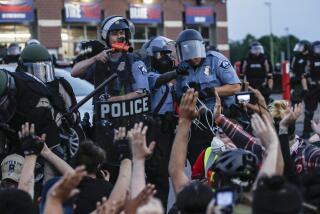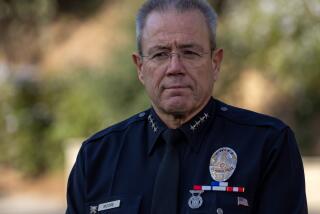Police lieutenant testifies kneeling on George Floydâs neck was âtotally unnecessaryâ

MINNEAPOLIS â Kneeling on George Floydâs neck while he was handcuffed and lying on his stomach was top-tier, deadly force and âtotally unnecessary,â the head of the Minneapolis Police Departmentâs homicide division testified Friday.
âIf your knee is on a personâs neck, that can kill him,â said Lt. Richard Zimmerman, adding that when a person is handcuffed behind their back, âyour muscles are pulling back ⌠and if youâre laying on your chest, thatâs constricting your breathing even more.â
Zimmerman, who said he is the most senior person on the police force, also testified at Derek Chauvinâs murder trial that once Floyd was handcuffed, he saw âno reason for why the officers felt they were in danger, if thatâs what they felt, and thatâs what they would have to feel to be able to use that kind of force.â
âSo in your opinion, should that restraint have stopped once he was handcuffed and thrown on the ground?â prosecutor Matthew Frank asked.
âAbsolutely,â Zimmerman replied, who said he has received use-of-force training annually â as all officers do â since joining the city force in 1985.
He said he has never been trained to kneel on someoneâs neck if theyâre handcuffed behind their back and in the prone position.
âOnce you secure or handcuff a person, you need to get them out of the prone position as soon as possible because it restricts their breathing,â Zimmerman said, adding that âyou need to turn them on their side or have them sit up.â
He also testified that officers have a duty to provide care for a person in distress, even if an ambulance has been called.
Officers kept restraining Floyd â with Chauvin kneeling on his neck, another kneeling on Floydâs back and a third holding his feet â until the ambulance arrived, even after he became unresponsive.
One officer asked twice if they should roll Floyd on his side to aid his breathing and later said calmly that he thought Floyd was passing out. Another checked Floydâs wrist for a pulse and said he couldnât find one.
The officers also rebuffed offers of help from an off-duty Minneapolis firefighter who testified she wanted to administer aid or tell officers how to do it.
During cross-examination, Chauvin attorney Eric Nelson peppered Zimmerman with questions about the use of force, pointing out that officers must consider the entire situation â including what is happening with a suspect, whether the suspect is under the influence and other surrounding hazards, such as a crowd.
The defense has argued that Chauvin did what he was trained to do when he encountered Floyd in May and that Floydâs death was caused not by the knee on his neck, as prosecutors contend, but by drugs, his underlying health conditions and adrenaline. An autopsy found fentanyl and methamphetamine in his system.
Chauvin is also heard on body-camera footage defending his decision to an onlooker after Floyd was taken away by paramedics, saying: âWe gotta control this guy âcause heâs a sizable guy ⌠and it looks like heâs probably on something.â
Chauvin, 45 and white, is charged with killing Floyd by pinning his knee on the 46-year-old Black manâs neck for about nine minutes as he lay face-down in handcuffs. Floyd was suspected of passing a counterfeit $20 bill at a neighborhood market.
Zimmerman agreed with Nelson that a person who is handcuffed can still pose a threat and can continue to thrash around.
And he agreed when Nelson asked if officers who believe theyâre in a fight for their lives could use âwhatever force is reasonable and necessary,â including by improvising.
âDid you see any need for Officer Chauvin to improvise by putting his knee on Mr. Floyd for 9 minutes and 29 seconds?â Frank later asked Zimmerman.
âNo, I did not,â said Zimmerman, who said that based on his review of police body-camera footage, the officers did not appear to be in danger from Floyd or about 15 onlookers.
Nelson has suggested that the bystanders â many of whom were shouting at Chauvin to get off Floyd â may have distracted officers and affected their response. The prosecution, however, noted that officers on the scene did not call for backup.
âThe crowd, as long as theyâre not attacking you, the crowd really doesnât, shouldnât, have an effect on your actions,â Zimmerman said.
Floydâs death triggered large protests around the U.S. and beyond, scattered violence and widespread soul-searching over racism and police brutality. The since-fired Chauvin is charged with murder and manslaughter, and if convicted, he could be sentenced to up to 40 years in prison.
More to Read
Sign up for Essential California
The most important California stories and recommendations in your inbox every morning.
You may occasionally receive promotional content from the Los Angeles Times.










